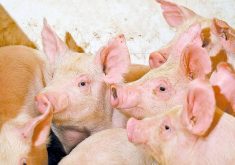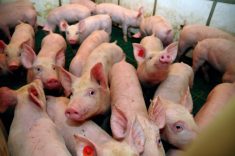Chicago | Reuters — The U.S. government on Friday raised its pork production forecast for the calendar year ending September 2015 that shows pork surpassing beef for the first time since 1952, as hog farmers rapidly recover from a deadly pig virus.
In the monthly World Agriculture Supply and Demand Estimates (WASDE), the U.S. Department of Agriculture raised the commercial pork production forecast for 2015 to 23.9 billion pounds.
That is a 2.6 per cent upward revision from last month’s data, a five per cent production increase versus 2014 and, for the first time in 62 years, exceeds beef output.
Read Also

U.S. grains: Soy futures dip as traders await China sales; corn, wheat sag
U.S. soybean futures retreated on Monday from a one-week top on a lack of fresh soy sales to top buyer China and lingering doubts over whether the Asian nation will buy 12 million tonnes of the oilseed by the end of 2025
USDA projected 2015 beef output at 23.8 billion lbs., with a marginal upward revision from the September report and a 2.3 per cent decline versus last year’s production.
The sooner-than-expected improvement by pork producers from the porcine epidemic diarrhea virus (PEDv), which killed an estimated eight million pigs since May 2013, will result in more hogs in 2015, said USDA and market analysts.
Hogs will become readily available as farms largely unaffected by the virus grow their herds, thanks largely to high-priced hogs and low-cost feed, analysts said.
On the other hand, it will take at least two years, the time for a calf to reach slaughter weight, before cattle ranchers can expect a turnaround in the U.S. herd from a 63-year low after several years of drought-damaged crops.
Friday’s WASDE data is catching up to the agency’s quarterly hog report in September, said Purdue University livestock economist Chris Hurt.
September’s hog data reflected herd growth based on increased litter sizes and more sows that will give birth, said Hurt.
Affordable feed should continue to allow producers to feed hogs heavier, which should increase tonnage that will offset expected production losses tied to PEDv, he said.
“PEDv just was not as extreme during the summer months as some had anticipated,” said Hurt.
— Reporting for Reuters by Theopolis Waters in Chicago.















